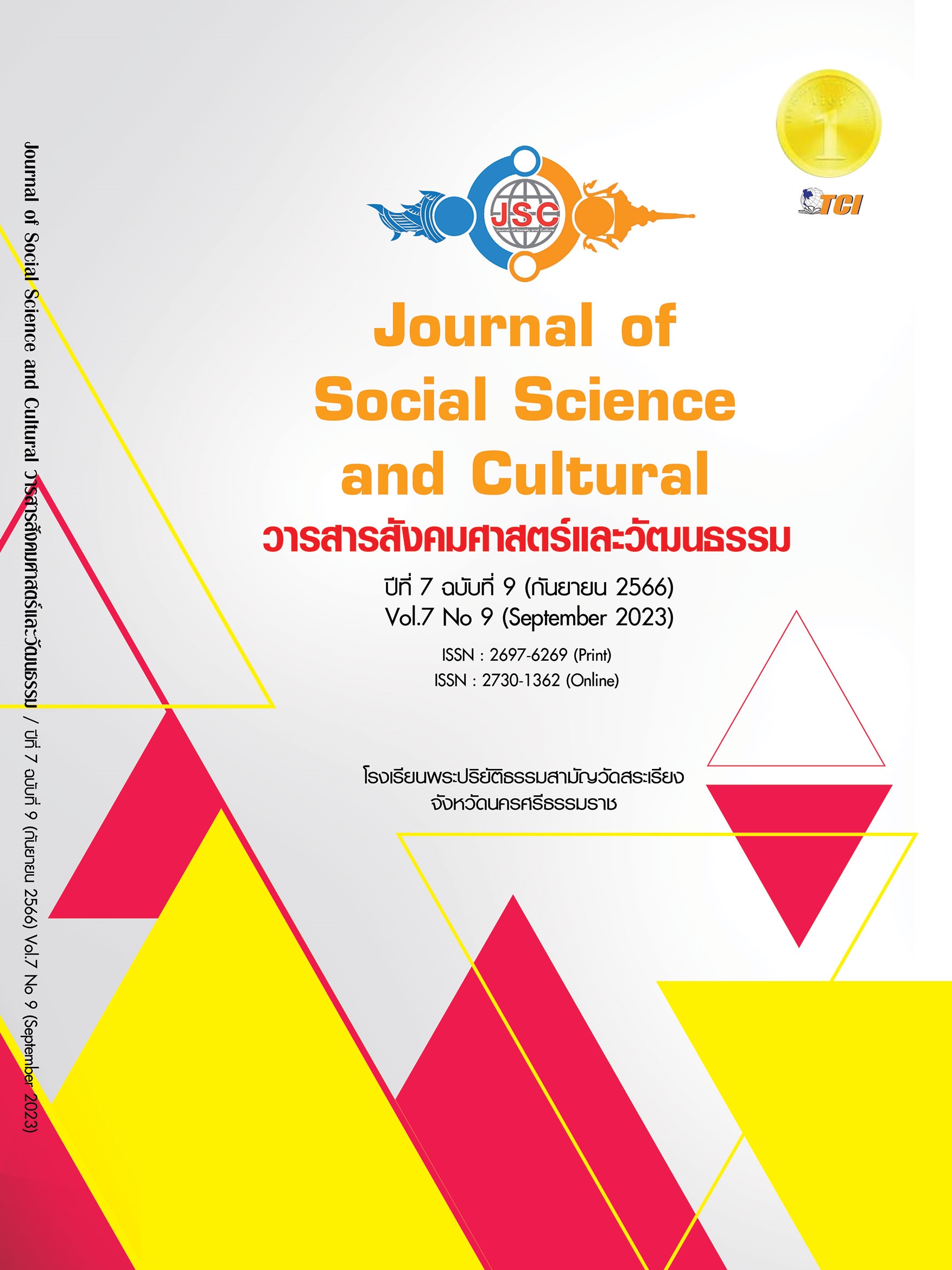BIORESIN: AN ALTERNATIVE MATERIAL TO RESIN FOR CONTEMPORARY NATURAL FABRIC DYEING
Main Article Content
Abstract
This research article focuses on the use of resin by creating alternative material called “bioresin” to apply in natural fabric dyeing process. The bioresin that is able to coat coffee grounds is created to apply in fabric dyeing process. The purposes of this research are as follows: 1) To study resin in order to design the process of making bioresin that can coat coffee grounds by studying related documents and interview experts in resin and natural pigment. And 2) To design the process of fabric dyeing using waste coffee grounds by applying bioresin with alcohol. The result found that: 1) Resin from yang na can be used to create bioresin by using Karaya gum as emulsion and glycerin as solvent. 2) The bioresin formula 13.5 with the ratio of resin: 28 g/glycerin: 46 g/gum karaya: 26 g is the formula that is suitable for coating coffee grounds (the pH values are between 4.50 - 5.00, which is not too acidic) and it is applied in the process of dyeing muslin fibers with coffee grounds by using alcohol instead of water as in the fabric dyeing formula 7 with the ratio of bioresin: 4 g/coffee: 6 g. In addition, it is found in the process of dyeing with alcohol that after the dyeing process has been done, the raw material can be kept to reuse in fabric dyeing again. This complies with the creation that recognizes the value of reusing raw material which brings about the development of contemporary fabric dyeing process rooted from the wisdom of sustainability.
Article Details
References
เก่ง กิติเรียงลาภ. (2564). ANTHROOCENE บทวิพากษ์มนุษย์และวิกฤตสิ่งแวดล้อมในยุคสมัยแห่ง. (พิมพ์ครั้งที่ 1). ศูนย์มานุษยวิทยาสิรินธร องค์การมหาชน: ภาพพิมพ์.
ไพรัตน์ ปุญญาเจริญนนท์ และคณะ. (2557). การพัฒนาการเตรียมสีผงจากการย้อมธรรมชาติ: งานวิจัยคณะสิ่งทอและออกแบบแฟชั่น. กรุงเทพมหานคร: มหาวิทยาลัยเทคโนโลยีราชมงคลพระนคร.
กรมควบคุมมลพิษ. (2566). รายงานการดำเนินงาน กองจัดการคุณภาพน้ำ พ.ศ. 2564. เรียกใช้เมื่อ 1 มิถุนายน 2566 จาก https://www.pcd.go.th/wp-content/uploads/2020/05/pcdnew-2020-05-20_04-16-18_565529.pdf
จักร พิชัยศรทัต. (2566). การย้อมผ้าด้วยสีจากธรรมชาติ. (พิมพ์ครั้งที่ 6). กรุงเทพมหานคร: สถาบันสร้างสรรค์งานศิลป์.
ธันวดี สุขประเสริฐ. (2564). ครุ. เรียกใช้เมื่อ 5 มิถุนายน 2566 จาก https://citly.me/E2NTD
ธีรพล อิ่มใจ. (26 ตุลาคม 2565). คุณสมบัติของยางไม้และประโยชน์ของยางไม้. (ดวงใจ อุชชิน, ผู้สัมภาษณ์)
บุศรินทร์ เลิศชวลิตสกุล และคณะ. (2565). ความรู้เบื้องต้นเกี่ยวกับสังคมร่วมสมัย. (พิมพ์ครั้งที่ 1). สำนักพิมพ์มหาวิทยาลัยนเรศวร: รัตนสุวรรณการพิมพ์ 3.
ภัทรนันท์ ทวดอาจ และคณะ. (2559). พลาสติกชีวภาพ: วัสดุทางเลือก Bioplastics: Alternative material. เรียกใช้เมื่อ 1 สิงหาคม 2566 จาก http://dspace.bru.ac.th/xmlui/handle/123456789/7276
วิธีการทำพลาสติกชีวภาพ. (2565). วิธีการที่ 1 ใช้แป้งข้าวโพดและน้ำส้มสายชู. เรียกใช้เมื่อ 3 มีนาคม 2566 จาก https://citly.me/r4EDk.
วิบูลย์ ลี้สุวรรณ. (2558). พจนานุกรมหัตถกรรมเครื่องมือเครื่องใช้พื้นบ้าน. (พิมพ์ครั้งที่ 4). กรุงเทพมหานคร: บริษัทวิริยะธุรกิจ จำกัด.
วีณา พันธุ์ธีรานุรักษ์ และคณะ. (2565). ย้อมรอย. เรียกใช้เมื่อ 1 สิงหาคม 2566 จาก https://readthecloud.co/thai-natural-dyes/
สมพงศ์ จันทร์โพธิ์ศรี. (2560). เคมีอินทรีย์ เล่ม 2. (พิมพ์ครั้งที่ 6). กรุงเทพมหานคร: วิทยพัฒน์.
อมรรัตน์ เลิศวรสิริกุล. (2554). พอลิแลกติกแอซิด: พอลิเอสเทอร์ จากทรัพยากรที่สร้างทดแทนใหม่ได้. วารสารวิศวกรรมสาร มก, 24(77), 99-110.
Kungten, P. (2023). What is caray gum. เรียกใช้เมื่อ 6 March 2023 จากhttp://baipaknaru.blogspot.com/2013/03/blog-post_1321.html.
Youyangsong, S. (2023). Youyang Song. Retrieved June 8, 2023, from https://youyangsong.com/


